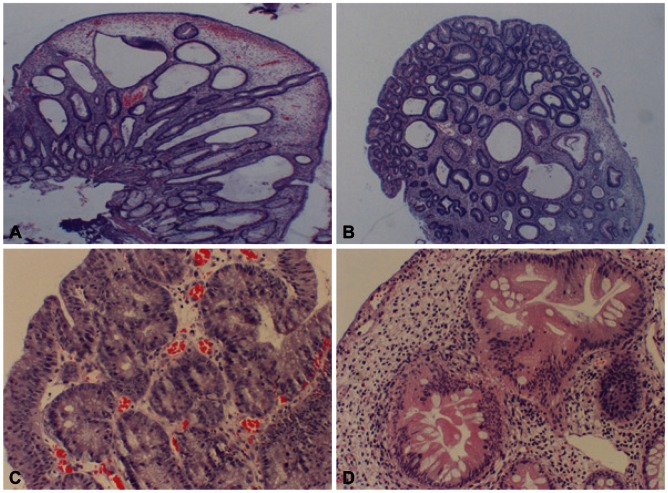Clin Endosc.
2013 May;46(3):301-305. 10.5946/ce.2013.46.3.301.
Cronkhite-Canada Syndrome Associated with Serrated Adenoma and Malignant Polyp: A Case Report and a Literature Review of 13 Cronkhite-Canada Syndrome Cases in Korea
- Affiliations
-
- 1Department of Internal Medicine, Presbyterian Medical Center, Jeonju, Korea. yz9017@daum.net
- KMID: 2048939
- DOI: http://doi.org/10.5946/ce.2013.46.3.301
Abstract
- Cronkhite-Canada syndrome (CCS) is a rare nonfamilial polyposis syndrome characterized by epithelial disturbances both in the gastrointestinal tract and in the epidermis. The pathologic finding of the polyp is usually a hamartomatous polyp of the juvenile type; however, the possibility of serrated adenoma associated malignant neoplasm was reported in some Japanese cases. Up till now in South Korea, 13 CCS cases have been reported, but there was no case accompanied by the colon cancer. We report the first case of CCS associated with malignant colon polyp and serrated adenoma in Korea. A 72-year-old male patient who complained of diarrhea and weight loss was presented with both hands and feet nail dystrophy, hyperpigmentation, and alopecia. Endoscopic examination showed numerous hamartomatous polyps from the stomach to the colon. The pathologic results confirmed colon cancer and serrated adenoma. Helicobacter pylori eradication and prednisolone was used. Thus, the authors report this case along with a literature review.
MeSH Terms
Figure
Cited by 1 articles
-
Cronkhite-Canada Syndrome Showing Good Early Response to Steroid Treatment
Woohee Cho, Kwangwoo Nam, Ki Bae Bang, Hyun Deok Shin, Jeong Eun Shin
Korean J Gastroenterol. 2018;71(4):239-243. doi: 10.4166/kjg.2018.71.4.239.
Reference
-
1. Daniel ES, Ludwig SL, Lewin KJ, Ruprecht RM, Rajacich GM, Schwabe AD. The Cronkhite-Canada Syndrome. An analysis of clinical and pathologic features and therapy in 55 patients. Medicine (Baltimore). 1982; 61:293–309. PMID: 7109958.2. Dachman AH, Buck JL, Burke AP, Sobin LH. Cronkhite-Canada syndrome: radiologic features. Gastrointest Radiol. 1989; 14:285–290. PMID: 2680733.
Article3. Goto A. Cronkhite-Canada syndrome: epidemiological study of 110 cases reported in Japan. Nihon Geka Hokan. 1995; 64:3–14. PMID: 8534187.4. Hizawa K, Nakamori M, Yao T, Matsumoto T, Iida M. A case of Cronkhite-Canada syndrome with colorectal adenomas: effect of the nonsteroidal anti-inflammatory drug sulindac. Am J Gastroenterol. 2007; 102:1831–1832. PMID: 17686082.
Article5. Riegert-Johnson DL, Osborn N, Smyrk T, Boardman LA. Cronkhite-Canada syndrome hamartomatous polyps are infiltrated with IgG4 plasma cells. Digestion. 2007; 75:96–97. PMID: 17510553.
Article6. Chadalavada R, Brown DK, Walker AN, Sedghi S. Cronkhite-Canada syndrome: sustained remission after corticosteroid treatment. Am J Gastroenterol. 2003; 98:1444–1446. PMID: 12818298.
Article7. Yashiro M, Kobayashi H, Kubo N, Nishiguchi Y, Wakasa K, Hirakawa K. Cronkhite-Canada syndrome containing colon cancer and serrated adenoma lesions. Digestion. 2004; 69:57–62. PMID: 14755154.
Article8. Kang YW, Park SK, Kim H, Bae OS, Chang ES. A case with some components of Cronkhite-Canada syndrome in a family with Peutz-Jeghers syndrome. Korean J Intern Med. 1988; 3:136–141. PMID: 3154191.
Article9. Lee SK, Kim MY, Choi SH, et al. One case of Cronkhite-Canada syndrome. Korean J Intern Med. 1992; 42:278–281.10. Choi MS, Kim YT, Jung HC, et al. A case of Cronkhite-Canada syndrome. Korean J Gastroenterol. 1992; 24:154–159.11. Park UC, Oh MH, Park EU, Kim SY, Seo JM, Park JG. A case report of Cronkhite Canada syndrome in the entire gastrointestinal tract. J Korean Soc Coloproctol. 1992; 8:173–180.12. Hong SJ, Kwon SH, Kim HJ, et al. A case of Cronkhite-Canada syndrome. Korean J Med. 1996; 51:825–831.13. Chung ST, Chung EC, Choi JH, Sung KJ, Moon KC, Koh JK. A case of Cronkhite-Canada syndrome. Korean J Dermatol. 1999; 37:381–385.14. Kim HJ, Jeen YT, Chun HJ, et al. Two cases of Cronkhite-Canada syndrome with remission. Korean J Gastrointest Endosc. 2000; 21:543–548.15. Goo YS, Shin HJ, Park JY, et al. A case of Cronkhite-Canada syndrome with a remission to steroid therapy. Korean J Gastrointest Endosc. 2001; 23:113–117.16. Kim MS, Jung HK, Jung HS, et al. A case of Cronkhite-Canada syndrome showing resolution with Helicobactor pylori eradication and omeprazole. Korean J Gastroenterol. 2006; 47:59–64. PMID: 16434870.17. Park W, Jeon WK, Lee JE, et al. A case of Cronkhite-Canada syndrome conducted with capsule endoscopy of small intestine. Korean J Gastrointest Endosc. 2010; 40:126–129.18. Baek JH, Kim TY. Cronkhite-Canada syndrome that developed in a patient taking levothyroxine sodium after total thyroidectomy. Korean J Dermatol. 2011; 49:45–49.19. Lee HJ, Park SJ, Choi HS, et al. A case of Cronkhite-Canada syndrome presenting with hematochezia. Intest Res. 2011; 9:238–242.
Article
- Full Text Links
- Actions
-
Cited
- CITED
-
- Close
- Share
- Similar articles
-
- A Case of Cronkhite-Canada Syndrome
- A Case of Cronkhite-Canada Syndrome with Esophageal Candidiasis
- Cronkhite-Canada Syndrome That Developed in a Patient Taking Levothyroxine Sodium after Total Thyroidectomy
- A Case of Cronkhite-Canada Syndrome Conducted with Capsule Endoscopy of Small Intestine
- Two Cases of Cronkhite - Canada Syndrome with Remission




